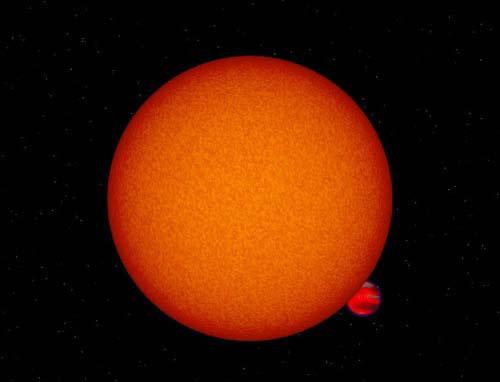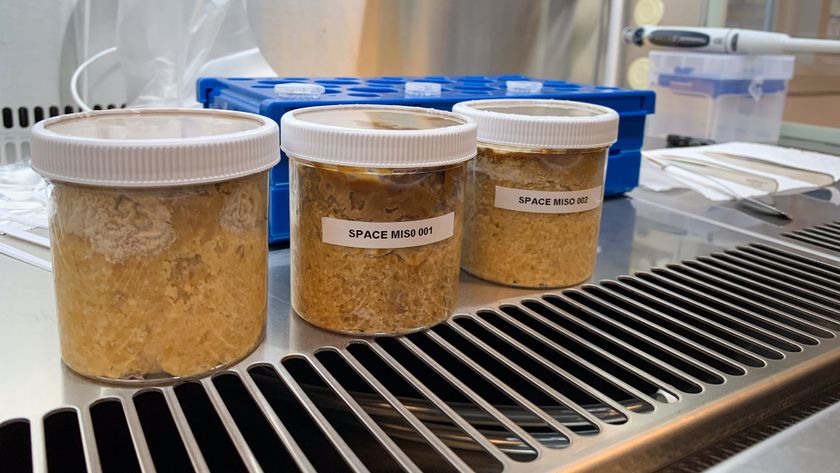Exoplanet Atmospheres Detected from Earth

Twoindependent groups of astronomers have detected the atmospheres of planetsaround other stars from ground-based telescopes.
Previousobservations of the atmospheres of extrasolar planets had been made almostentirely by space-based instruments, such as the Hubble and Spitzer spacetelescopes, although another ?team last year detected the signature of sodiumin an exoplanet atmosphere.
To date,astronomers have detected several key gases in planets' atmospheres, including:
- Carbon dioxide ? a potential sign of life, though the planet where the gas was observed was too hot to be habitable.
- Water vapor ? a key molecule required to support life as we know it.
- Silicates (combinations of silicon and oxygen) ? components of most rocks on Earth, likely in the form of clouds of dust grains on massive exoplanets.
- Sodium ? detected in 2001, it marked the first space-based observation of an exoplanet atmosphere.
Ground-baseddetection is becoming a priority as Hubble ages and Spitzer is set to run outof cryogens, which keep its instruments cool enough to detect infraredradiation (heat), limiting its abilities.
"Othershave tried to detect planetary atmospheres from Earth, but to no avail,"said the co-author of one of the new studies, Mercedes L?pez-Morales of theCarnegie Institution in Washington, D.C. "We hit it right two nights lastsummer."
L?pez-Moralesand her team observed the planet OGLE-TR056b, a so-called "hotJupiter."
HotJupiters
Get the Space.com Newsletter
Breaking space news, the latest updates on rocket launches, skywatching events and more!
HotJupiters are massive gaseous planets that orbit very close to their stars,whipping around them in two to three days. Their proximity to their parentstars indicates the planets are hot enough to emit radiation in the optical andnear-infrared wavelengths and that their radiation is detectable from Earth.
ButOGLE-TR056b is faint, sitting about 5,000 light-years away and in a crowdedpart of the night sky, located in the direction of the center of our galaxyfrom the Earth's perspective. So L?pez-Morales and her colleagues used theEuropean Southern Observatory's VeryLarge Telescope (on July 2) and Carnegie's Magellan-Baade telescope (onAug. 3). Both telescopes are located in Chile.
Only aboutone out of every 3,000 photons from the star comes from the planet itself. Therest is from the overwhelming light of the star. So astronomers wait until theplanet is eclipsed as it orbits behind the star (from the Earth's perspective),which allows for separation of the emissions of the planet from those of thestar.
"Theplanet is glowing red-hot like a kitchen stove burner, but we had to knowprecisely when the eclipse was going to happen and measure the stellar fluxvery accurately so it could be removed to reveal the planet's thermalemissions," said lead author of the study David Sing of Institutd'Astrophysique de Paris.
Real hot
The teamtook more than 600 images of OGLE-TR056b with both telescopes. The planet ishotter than any detected by Spitzer so far ? its atmosphere is more than 4,400degrees Fahrenheit (2,400 degrees Celsius).
Theobservations also indicated that the planet has little to no cloud cover and astatic atmosphere with little circulation, L?pez-Morales told SPACE.comin an email.
Their workwill be detailed in an upcoming issue of the journal Astronomy &Astrophysics.
In the sameissue of the journal, a Dutch team will explain their detection of the thermalemission in the near-infrared of another exoplanet dubbed TrES-3b. Itsatmosphere registered at about 3,000 F (1,700 C).
- Video: Planet Hunter
- Carbon Dioxide Detected on Faraway World
- Images: Spitzer Photo Album
Join our Space Forums to keep talking space on the latest missions, night sky and more! And if you have a news tip, correction or comment, let us know at: community@space.com.

Andrea Thompson is an associate editor at Scientific American, where she covers sustainability, energy and the environment. Prior to that, she was a senior writer covering climate science at Climate Central and a reporter and editor at Live Science, where she primarily covered Earth science and the environment. She holds a graduate degree in science health and environmental reporting from New York University, as well as a bachelor of science and and masters of science in atmospheric chemistry from the Georgia Institute of Technology.










